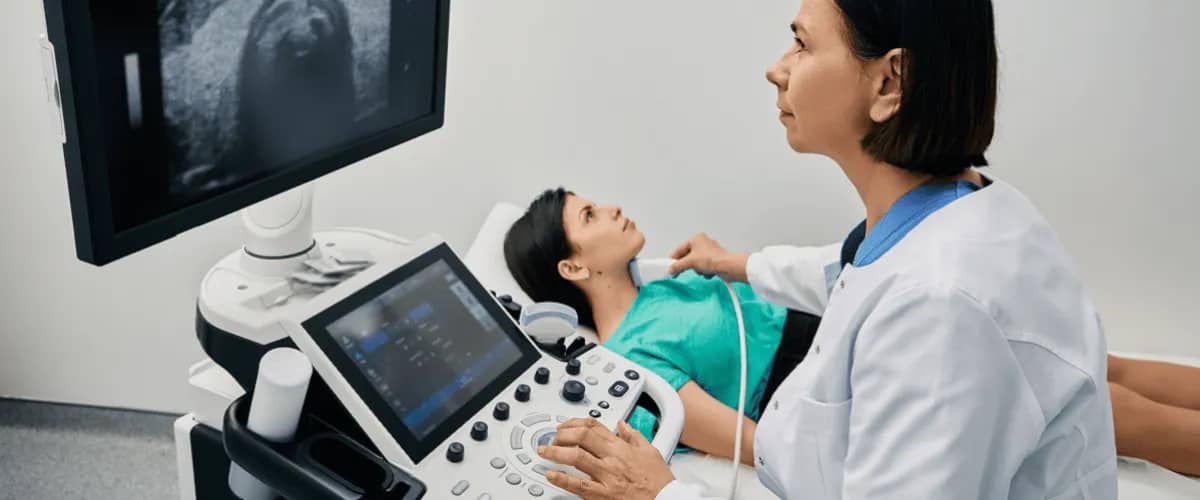Ultrasound is a widely used imaging technology with numerous applications, and that’s why it is essential for those in the field of diagnostics to familiarise themselves with it. It is a non-invasive method and it does not use ionising radiation—which makes people less hesitant to choose it. It also speeds up the diagnostic process by providing useful and accurate information in a timely manner.
How does ultrasound work?
Ultrasound is an imaging technology where frequency sound waves are used to create images of the inside of the body. The sound waves are transmitted through a small transducer into the body. The sound waves then bounce off the organs and return to the transducer which converts them into electrical signals.
After the patient lies down, a clear water-based liquid is applied to the skin—on the area that is going to be examined. This gel helps the transmission of the sound waves. Then the transducer is moved over the area. For other areas to be examined, the patient may need to switch position.
The exact frequency of the sound waves depends on the part of the body that is being imaged: Superficial structures require higher frequencies, while deeper structures need lower frequencies.
Some of the conditions that an ultrasound can diagnose are blood flow problems, gallbladder disease, breast lumps, genital and prostate issues, joint inflammation and others. It also helps monitor a woman’s pregnancy or guides biopsies.
What does an ultrasound technician do?
Typically, ultrasound imaging is performed by a specially trained healthcare professional, also known as an ultrasound technician or a sonographer.
The main responsibility of the ultrasound technician is to help diagnose and monitor medical conditions by creating images of the inside of the patient’s body and then forwarding them to a physician.
Some of the duties associated with the ultrasound technician are those that apply to all radiologists, no matter the imaging technique they specialise in:
- Examine patients
- Obtain medical histories
- Diagnose illnesses
- Recommend treatment
Apart from that, the ultrasound technician is the one operating the equipment to capture images of the internal structures of the body. The quality of the final images depends on the expertise of the technician. So, it is essential that the person in charge has the required experience and skills associated with the job. If the images cannot be used for a diagnosis, the scan has to be repeated.
Preparing a patient for ultrasound
One of the various tasks performed by sonographers is preparing patients for the ultrasound scan which includes explaining the purpose of the exam and how it is going to be performed. This way patients know what exactly will happen to them and they are less likely to worry and move unexpectedly—which would decrease the quality of the images.
The duration of ultrasound depends on several factors: from the type of exam that is performed to the area of the body that is being examined as well as the cooperation of the patient. More often than not ultrasound can take at least 30 minutes and at most an hour.
Ultrasound: Strengths & limitations
Ultrasound comes with both advantages and disadvantages, just like other imaging techniques. It is good to remember that—although it might excel in some areas—it has limitations, too. For some patients, other diagnostic techniques may prove to be more efficient.
Advantages of ultrasound
- Versatility: Ultrasound can be used to examine different parts of the body which makes it a useful tool in medical specialities such as cardiology, obstetrics and gynaecology. It can also be combined with other imaging techniques like MRI or CT in order to provide a comprehensive diagnosis. The equipment is easier to transport as well.
- Non-invasive: Some diagnostic techniques require a surgical approach which is not a pleasant experience for patients. Fortunately, ultrasound is non-invasive—making it the ideal choice for many.
- Safety: Ultrasound is a great option for pregnant women or people who don’t want to deal with the potential consequences of radiation because it uses frequency sound waves instead of ionising radiation.
- Real-time imaging: During ultrasound, doctors can see the organs inside the body as they function in real-time. Thus, they can detect abnormalities right away. This advantage is also useful during surgical procedures when the surgeon needs to be guided to perform the operation without endangering the patient’s safety.
- Cost-effectiveness: Finally, ultrasound is for many people the more accessible option out of all imaging techniques. That’s because the equipment used during ultrasound is less expensive compared to MRI or CT.
Disadvantages of ultrasound
- Visualisation: Although we mentioned earlier that ultrasound can be used to examine different parts of the body, not all of them provide the same amount of information. Some structures, like the lungs, are more difficult to see.
- Diagnosis ability: If performing an ultrasound is not providing enough information about the patient’s health, the scan must be combined with other imaging techniques that can fill in the blanks. However, this takes time and the final cost of the treatment will be higher than first expected.
- Penetration: During ultrasound, sound waves penetrate tissues to provide information. Some patients have thick abdominal walls which are much more difficult for the sound waves to penetrate. Contrast-enhanced ultrasound or harmonic imaging can fix this issue.
- Quality: The quality of the obtained images varies depending on the skill of the ultrasound technician who was tasked with it. That is why, although two technicians work at the same clinic and use identical equipment, they can produce different results.
- False positives: Ultrasound, similarly to other diagnostic techniques, can produce false positives which lead to varying levels of stress in the patient who is being examined.
All in all, ultrasound is a useful tool in diagnosing and monitoring a wide range of medical conditions. Performing it would not be possible without skilled and experienced technicians. It has both strengths and limitations which need to be taken into consideration from the beginning, so patients can benefit from the most efficient diagnosis techniques.





